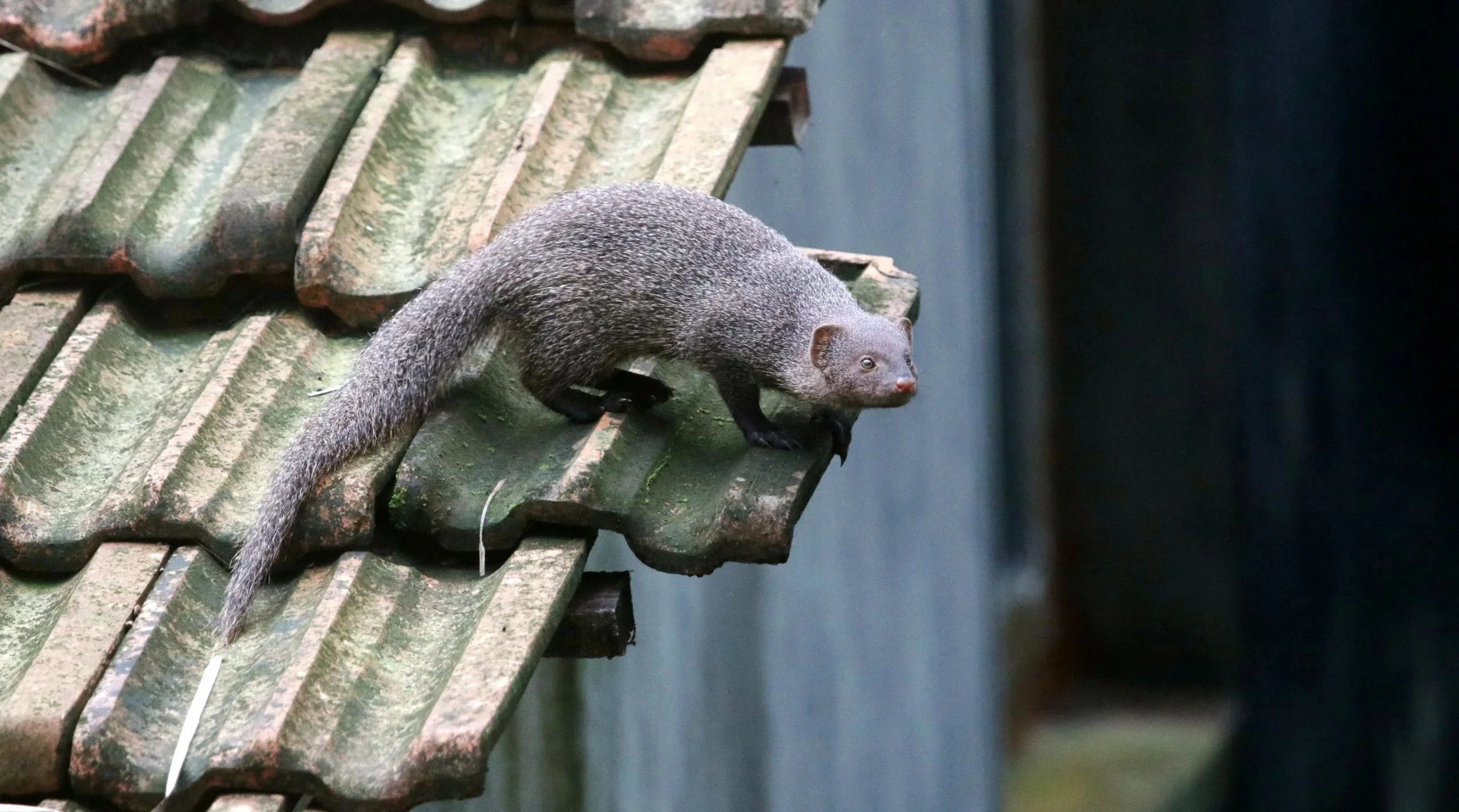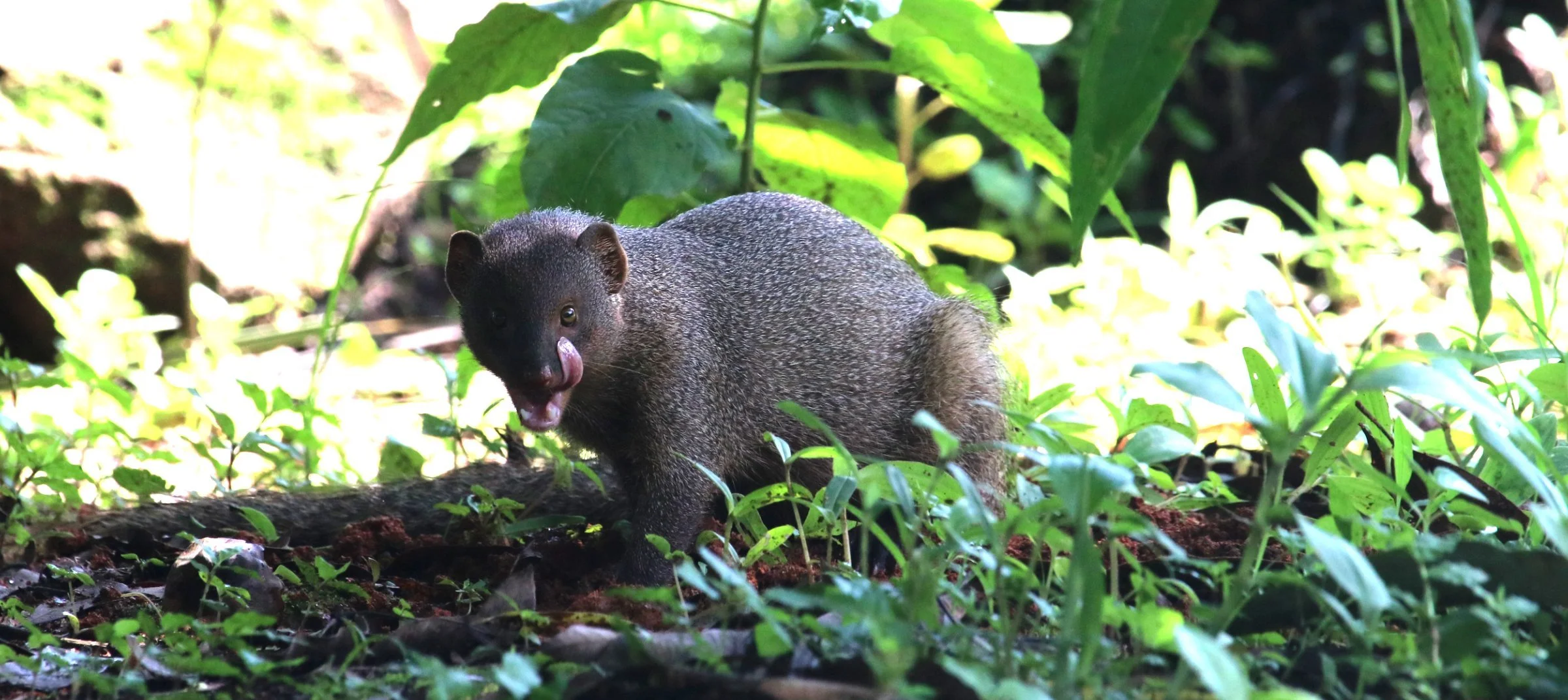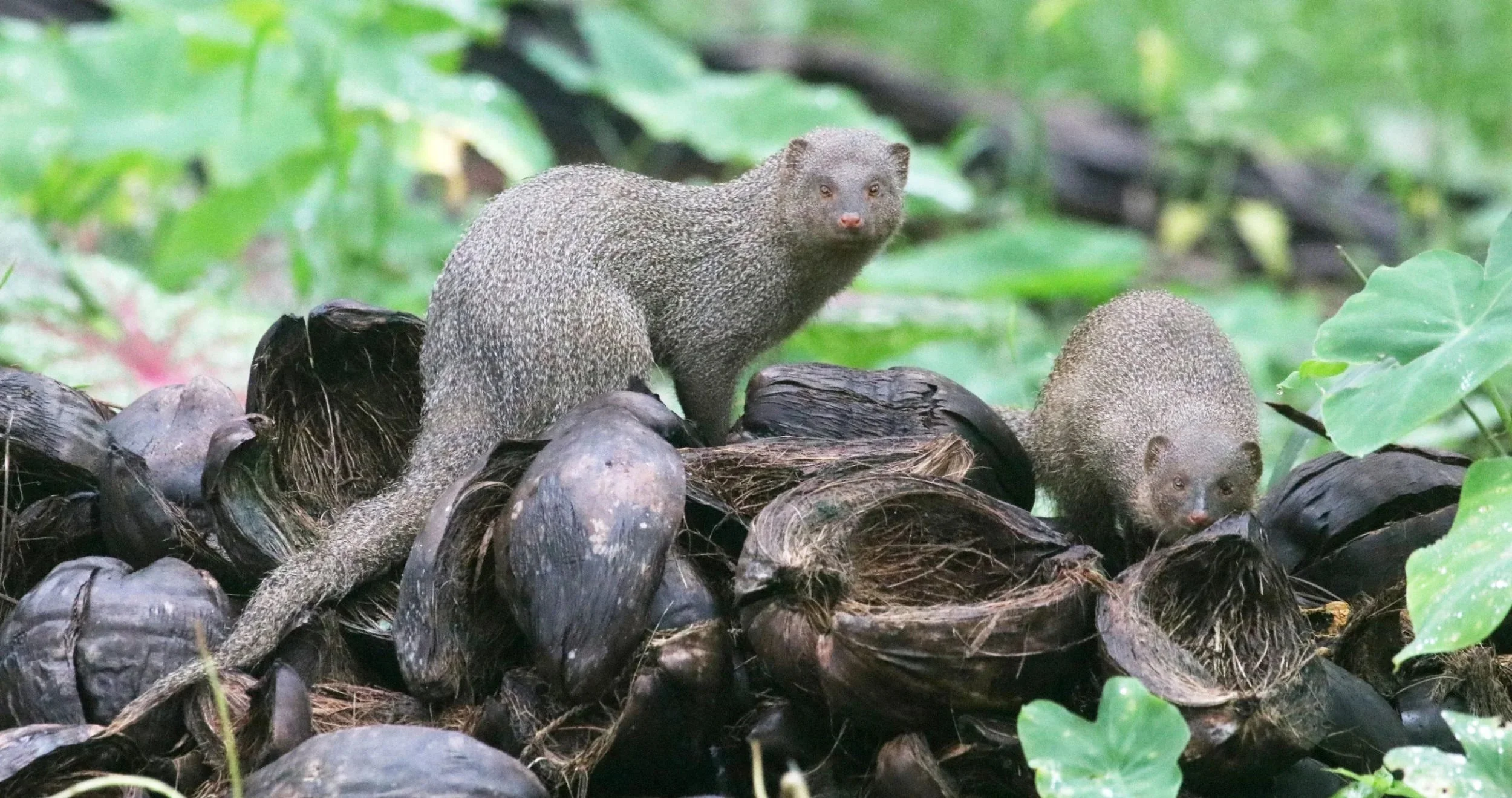ಈ ಲೇಖನ ಕನ್ನಡಲ್ಲೂ ಇದೆ, ದಯವಿಟ್ಟು ಪುಠದ ಕೊನೆಯ ಭಾಗಕ್ಕೆ ಹೋಗಿ / This article is available in Kannada language as well, kindly scroll to the end of the English article.
When trying to capture a photo of a bird or a snake or a mongoose, I’m dealing with two systems. One: the subject, let’s say a mongoose in its habitat. Another is I, the photographer in my body-mind. Capturing any meaningful photo is a kind of meditation that needs a certain harmony of both the external environment and my inner environment.
I absolutely cannot control the external environment. I can attempt certain tricks, but the harder I try, it’ll become a “studio” shot, and the “wild” in wildlife photography no longer becomes relevant. So that leaves only me as the variable to play with. This is where my practice becomes crucial. Using the word “control” is perhaps the wrong one, it’s more like “knowing”.
There are many aspects to this play. I’ll go one by one, in no particular order.
First, the tool. The camera. I need to know at the least, a minimal set of operational mastery to get the right amount of light captured, in the right frame. The more I practice, the more natural it becomes to make this my “default” frame and start with optimal default settings, the exposure, balance of camera and the composition.
Then, knowing my own habits and learning to overcome them. One such example: I have a tendency to click a burst of two shots and stop. I have no idea why I stop at two and not go on until the camera stops. I’ve missed many possible good action shots because of this habit. So, I’ve made a practice to explicitly set an intention to click as many as I can. I’m getting better, one missed opportunity at a time.
Then there is breathing. I have to hold my breath to be steady in order to click when things happen. Thus a certain amount of breath control is necessary too. Then the ability to hold the camera steady for a long while, especially when I’m not using a support like tripod or resting my hands on a tree stump. I can now hold the camera more or less steady for up to 5-6 minutes, excruciating pain notwithstanding. My maximum record is 12 minutes waiting for the peacock to take off from my rooftop. It didn’t.
Next up: my movements. It took a while to truly understand that I am a foreign entity for the animals when I enter their habitat. I mostly shoot backyard wildlife in our shared habitat, such as the garden, the nearby pond or the paddy fields. Even if it’s a shared habitat, animals are more at ease when I appear less threatening. What does “less threatening” mean to each animal varies. I need to learn one species at a time, sometimes it varies even with individual animals. Some tolerate me being fairly close, like bulbuls and babblers while a cormorant flies away at the first sign of me approaching. So, it's trial and error as well as being aware of each movement of mine. With certain rat snakes, we’ve become completely non-threatening to each other. Just two living things chilling around.
Not reacting to unexpected sounds and movements is also necessary. It's counter-intuitive: I'm training myself to click at the slightest change, yet I must ignore some inputs while staying alert to others. I react only to the subject in front of me; everything else, I become transparent to. A coconut thuds nearby? The animal will react, I shouldn't. In fact, I should be ready to click if it reacts in an interesting way. Ants biting my legs? It's a battle of my pain threshold vs ant's vengeance. Ants usually win after a while though.
Another habit I’ve developed is to talk to the animals. Not a loud conversation of course, but just whispering things like “oh hello, sorry didn’t see ya there, it’s cool. You know me” at the egrets. It helps me to become a gentler version of myself. I love talking to owls. They don’t give a hoot.
Another is knowing how to use the features of the habitat itself for my advantage: to hide behind a tree, or to duck behind a compound or to lie flat within the tall grass. There are no rules here, the only upper limit is my comfort and safety.
Yet another perspective is to learn to be slow and very very deliberate in my movements. For each step I lose a field of awareness, a field of view that’s no longer visible to me and I gain a newer area that comes to my awareness. As I move, I need to be aware of the field of view I’m uncovering to see what might be lurking there.
Now the external world:
A fundamental trick is to know how different animals react to one another. At the first sign of a dog far away, the mongoose either bolts to nearby safety or stands on its hind legs to gain a better vantage point, which makes a great shot. Bulbuls fly when a pigeon approaches. It’s rare to see two egrets tolerating each other when they come for a sip of water. Crows and babblers share a space with no qualms.
Then there's their behavior during special occasions such as mating season or caretaking their babies. Peacocks and peahens have a strict protocol for consenting to mate. Parakeets kiss each other. Juvenile birds usually flutter their undeveloped wings when momma feeds them.
Another thing to know is the habitat of animals and their preferences. Entering a pond area? Almost guaranteed to see an egret or a heron. Move fast, and I’ll scare them away. If I’m ignorant then their sudden movements will scare me! Walking along the paddy fields? Watch out for a peafowl to fly away out of nowhere from the hidden tall grass. Crossing a narrow stream of water in the monsoon? I might get to see a keelback if I’m slow enough.
There are a few cardinal rules I will never break.
1. No photos of bird nests. It is tempting to take that frame of baby birds sticking their neck out in unison when momma bird comes with food. But no. I resist, because going anywhere near the nest knowingly is straight up compromising their fragile home.
2. No interfering with the natural order. Each animal has to eat, and I cannot interfere with that, however brutal it may feel.
3. If I sense that my presence is making the animal jittery, I walk away. That photo can wait. Video need not be captured. Mistakes do happen, but I learn.
Last one but perhaps the most important one is not to give up. I still haven’t managed to click the cliched shot of kingfisher fishing out the fish nor have I managed the picture of the stand off between a cobra and the mongoose. I know I will keep at it.
All said and done, none of these guarantee a clean shot. But they all help me anticipate the subject's movements and let me peek into the future perhaps about a second or two. As I hear the dog bark nearby, I know the mongoose is going to either stand up or bolt. I gently hold my breath, arms steady, index finger with a feather touch on the shutter. I let go of everything else around and focus only on the mongoose. I can almost sense the next movement. Click click click.
Footnote:
Read more about wildgundmi project here - https://wildgundmi.com/about
Watch the documentary I made using backyard wildlife footages here - https://www.youtube.com/watch?v=5SdsNB335dY
ಮುಂಗುಸಿಗಳ ಜೊತೆಗೆ ಧ್ಯಾನ : wildgundmi.com ಮಾಡುವಾಗ ಕಲಿತ ಪಾಠಗಳು:
ಪ್ರಾಣಿ ಪಕ್ಷಿಗಳ ಛಾಯಾಚಿತ್ರ ತೆಗೆಯುವ ಪ್ರಯತ್ನ ಮಾಡುವಾಗ ನಾನು ಎರಡು ವಿಷಯಗಳೊಂದಿಗೆ ವ್ಯವಹರಿಸುತ್ತೇನೆ. ಒಂದು: ಪ್ರಾಣಿ ಮತ್ತು ಅದರ ಪರಿಸರ. ಇನ್ನೊಂದು : ನಾನು ಮತ್ತು ನನ್ನ ಆಂತರಿಕ ಪರಿಸರ, ಮನಸ್ಸು ಮತ್ತು ದೇಹ. ಅರ್ಥವತ್ತಾದ ಛಾಯಾಚಿತ್ರ ತೆಗೆಯಲು ಈ ಎರಡು ವಿಷಯಗಳು ಒಂದು ತರಹದ ಸಮರಸ್ಯದೊಂದಿಗೆ ನೃತ್ಯ ಮಾಡಬೇಕಾಗುತ್ತದೆ.
ಹೊರಗಿನ ಪರಿಸರವನ್ನು ನಾನು ನಿಯಂತ್ರಣ ಮಾಡಲು ನನಗೆ ಸಾಧ್ಯವಿಲ್ಲ. ಬಹಳ ಪ್ರಯತ್ನ ಮಾಡಿದರೆ ಅದು ವನ್ಯ ಛಾಯಾಗ್ರಾಹನದ "ವನ್ಯ" ಭಾಗವಕ್ಕೆ ಅಗೌರವ ಕೊಟ್ಟ ಹಾಗೆ! ಆದ್ದರಿಂದ ನಿಯಂತ್ರಣ ಮಾಡಲು ಸಾಧ್ಯ ಇರುವುದು ಬರೀ ಒಂದೇ ವಿಷಯ: ನನ್ನ ದೇಹ, ಮನಸ್ಸು ಮತ್ತು ಚಲನೆಗಳು. "ನಿಯಂತ್ರಣ" ಎನ್ನೂವುದೂ ತಪ್ಪಾಗಬಹುದು, "ಕಲಿತುಕೊಳ್ಳುವುದು" ಎಂದರೆ ಸರಿಯಾಗ ಬಹುದು.
ಈ ನ್ರತ್ಯಕ್ಕೆ ಬಹಳ ತರಹದ ಅಂಶಗಳಿವೆ, ಒಂದೊಂದಾಗಿ ಬರೆಯುವೆನು ಇಲ್ಲಿ :
ಮೊದಲು, ಉಪಕರಣ. ಕ್ಯಾಮೆರಾ. ಸರಿಯಾದ ಚೌಕಟ್ಟಿನಲ್ಲಿ ಸರಿಯಾದ ಪ್ರಮಾಣದ ಬೆಳಕನ್ನು ಸೆರೆಹಿಡಿಯಲು ಕನಿಷ್ಠ ಕಾರ್ಯಾಚರಣೆಯ ಪಾಂಡಿತ್ಯವನ್ನು ನಾನು ತಿಳಿದುಕೊಳ್ಳಬೇಕು. ನಾನು ಹೆಚ್ಚು ಅಭ್ಯಾಸ ಮಾಡಿದಷ್ಟೂ, ಇದನ್ನು ನನ್ನ ಸೂಕ್ತ default settings ,exposure , ಕ್ಯಾಮೆರಾದ ಸಮತೋಲನ ಮತ್ತು ಸಂಯೋಜನೆಯೊಂದಿಗೆ ಪ್ರಾರಂಭಿಸುವುದು ಹೆಚ್ಚು ಸ್ವಾಭಾವಿಕವಾಗುತ್ತದೆ.
ನಂತರ, ನನ್ನ ಸ್ವಂತ ಅಭ್ಯಾಸಗಳನ್ನು ತಿಳಿದುಕೊಳ್ಳುವುದು ಮತ್ತು ಅವುಗಳನ್ನು ಬದಲಾಯಿಸಲು ಕಲಿಯುವುದು. ಒಂದು ಉದಾಹರಣೆ: ನನಗೆ ಎರಡೇ click ಸಿಡಿಸಿ ನಿಲ್ಲಿಸುವ ಪ್ರವೃತ್ತಿ ಇದೆ. ನಾನು ಎರಡರಲ್ಲಿ ನಿಲ್ಲಿಸುವುದು ಏಕೆ? ಕ್ಯಾಮೆರಾ ನಿಲ್ಲುವವರೆಗೂ ಏಕೆ ಮುಂದುವರಿಯುವುದಿಲ್ಲ ಎಂದು ನನಗೆ ತಿಳಿದಿಲ್ಲ. ಈ ಅಭ್ಯಾಸದಿಂದಾಗಿ ನಾನು ಅನೇಕ ಉತ್ತಮ ಛಾಯಾಚಿತ್ರಗಳ್ಳನ್ನು ತಪ್ಪಿಸಿಕೊಂಡಿದ್ದೇನೆ. ಆದ್ದರಿಂದ, ಸಾಧ್ಯವಾದಷ್ಟು ಕ್ಲಿಕ್ ಮಾಡುವ ಉದ್ದೇಶವನ್ನು ಸ್ಪಷ್ಟವಾಗಿ ಹೊಂದಿಸಲು ನಾನು ಅಭ್ಯಾಸ ಮಾಡಿದ್ದೇನೆ!
ನಂತರ ಉಸಿರಾಟದ ಆಟ! ಏನಾದರೂ ಸಂಭವಿಸಿದಾಗ ಕ್ಲಿಕ್ ಮಾಡಲು ನಾನು ನನ್ನ ಉಸಿರನ್ನು ಸ್ಥಿರವಾಗಿ ಹಿಡಿದಿಟ್ಟುಕೊಳ್ಳಬೇಕು. ಹೀಗಾಗಿ ಸ್ವಲ್ಪ ಪ್ರಮಾಣದ ಉಸಿರಾಟದ ನಿಯಂತ್ರಣವೂ ಅಗತ್ಯ. ವಿಶೇಷವಾಗಿ ನಾನು ಟ್ರೈಪಾಡ್ನಂತಹ ಬೆಂಬಲವನ್ನು ಬಳಸದಿದ್ದಾಗ ಅಥವಾ ಮರದ ಬುಡದ ಮೇಲೆ ನನ್ನ ಕೈಗಳನ್ನು ಇಡದಿದ್ದಾಗ ಕ್ಯಾಮೆರಾವನ್ನು ದೀರ್ಘಕಾಲದವರೆಗೆ ಸ್ಥಿರವಾಗಿ ಹಿಡಿದಿಟ್ಟುಕೊಳ್ಳುವ ಸಾಮರ್ಥ್ಯ ಬೇಕು. ಈಗ ನಾನು 5-6 ನಿಮಿಷಗಳವರೆಗೆ ಕ್ಯಾಮೆರಾವನ್ನು ಹೆಚ್ಚು ಕಡಿಮೆ ಸ್ಥಿರವಾಗಿ ಹಿಡಿದಿಟ್ಟುಕೊಳ್ಳಬಲ್ಲೆ, ಅಸಹನೀಯ ನೋವು ಇದ್ದರೂ ಸಹ. ನನ್ನ ಗರಿಷ್ಠ ದಾಖಲೆ: ನವಿಲು ನನ್ನ ಛಾವಣಿಯಿಂದ ಹಾರಲು 12 ನಿಮಿಷ ಕಾಯ್ದಿದು, ಆದರೆ ಅದು ಹಾರಲೇ ಇಲ್ಲ!
ಮುಂದಿನದು: ನನ್ನ ಚಲನವಲನಗಳು. ನಾನು ಪ್ರಾಣಿಗಳ ಆವಾಸಸ್ಥಾನವನ್ನು ಪ್ರವೇಶಿಸಿದಾಗ ನಾನು ಅವುಗಳಿಗೆ ವಿದೇಶಿ ಜೀವಿ ಎಂದು ನಿಜವಾಗಿಯೂ ಅರ್ಥಮಾಡಿಕೊಳ್ಳಲು ಸ್ವಲ್ಪ ಸಮಯ ಹಿಡಿಯಿತು. ನಾನು ಹೆಚ್ಚಾಗಿ ನಮ್ಮಮನೆ, ತೋಟದ ಆವಾಸಸ್ಥಾನದಲ್ಲಿ, ಉದ್ಯಾನ, ಹತ್ತಿರದ ಕೊಳ ಅಥವಾ ಭತ್ತದ ಗದ್ದೆಗಳಂತಹ ಹಿತ್ತಲಿನ ವನ್ಯಜೀವಿಗಳನ್ನು ಚಿತ್ರೀಕರಿಸುತ್ತೇನೆ. ನಾನು ಕಡಿಮೆ ಬೆದರಿಕೆಯಾಗಿ ಕಾಣಿಸಿಕೊಂಡಾಗ ಪ್ರಾಣಿಗಳು ಹೆಚ್ಚು ನಿರಾಳವಾಗಿರುತ್ತವೆ. "ಕಡಿಮೆ ಬೆದರಿಕೆ" ಎಂದರೆ ಏನು ಎನ್ನುವುದು ಪ್ರತಿ ಪ್ರಾಣಿಗೂ ಬದಲಾಗುತ್ತದೆ. ನಾನು ಒಂದು ಸಮಯದಲ್ಲಿ ಒಂದು ಜಾತಿಯನ್ನು ಪ್ರಾಣಿಗಳ ಬಗ್ಗೆ ಕಲಿಯಬೇಕಾಗುತ್ತದೆ. ನಾನು ಸಮೀಪಿಸುವ ಮೊದಲ ಚಿಹ್ನೆಯಲ್ಲಿನೀರುಕಾಗೆ ಹಾರಿಹೋಗುತ್ತದೆ! ಬಲ್ಬುಲ್ಗಳು ಮತ್ತು ಬಾಬ್ಲರ್ಗಳಂತ ಪಕ್ಷಿಗಳು ನಾನು ಸಾಕಷ್ಟು ಹತ್ತಿರವಾಗಿರುವುದನ್ನು ಸಹಿಸಿಕೊಳ್ಳುತ್ತಾರೆ. ಆದ್ದರಿಂದ, ಇದು ಪ್ರಯೋಗ ಮತ್ತು ದೋಷದ ಜೊತೆಗೆ ನನ್ನ ಪ್ರತಿಯೊಂದು ಚಲನೆಯ ಬಗ್ಗೆತಿಳಿದು ಕಲಿಯುವ ಆಟ. ಕೆಲವು ಹಾವುಗಳೊಂದಿಗೆ, ನಾವು ಪರಸ್ಪರ ಸಂಪೂರ್ಣವಾಗಿ ಬೆದರಿಕೆಯಿಲ್ಲದವರಾಗಿದ್ದೇವೆ!
ಅನಿರೀಕ್ಷಿತ ಶಬ್ದಗಳು ಮತ್ತು ಚಲನೆಗಳಿಗೆ ಪ್ರತಿಕ್ರಿಯಿಸದಿರುವುದು ಸಹ ಅಗತ್ಯ. ಹತ್ತಿರದಲ್ಲಿ ಬೀಳುವ ತೆಂಗಿನಕಾಯಿಯ ಸದ್ದು ಕೇಳಿದರೆ ಪ್ರಾಣಿ ಖಂಡಿತವಾಗಿಯೂ ಪ್ರತಿಕ್ರಿಯಿಸುತ್ತದೆ, ಮತ್ತುನಾನೂ ಹಾಗೆ ಮಾಡಬಾರದು. ವಾಸ್ತವವಾಗಿ, ಅದು ಆಸಕ್ತಿದಾಯಕ ರೀತಿಯಲ್ಲಿ ಪ್ರತಿಕ್ರಿಯಿಸಿದರೆ ನಾನು ಕ್ಲಿಕ್ ಮಾಡಲು ಸಿದ್ಧನಾಗಿರಬೇಕು. ಇರುವೆಗಳು ನನ್ನ ಕಾಲುಗಳನ್ನು ಕಚ್ಚುತ್ತವೆಯೇ? ಇದು ನನ್ನ ನೋವಿನ ಮಿತಿ ಮತ್ತು ಇರುವೆಯ ಪ್ರತೀಕಾರದ ನಡುವಿನ ಹೋರಾಟ! ಸ್ವಲ್ಪ ಸಮಯದ ನಂತರ ಇರುವೆಗಳು ಸಾಮಾನ್ಯವಾಗಿ ಗೆಲ್ಲುತ್ತವೆ.
ನಾನು ಬೆಳೆಸಿಕೊಂಡಿರುವ ಇನ್ನೊಂದು ಅಭ್ಯಾಸವೆಂದರೆ ಪ್ರಾಣಿಗಳೊಂದಿಗೆ ಮಾತನಾಡುವುದು. ಖಂಡಿತವಾಗಿಯೂ ಜೋರಾಗಿ ಮಾತನಾಡುವುದಿಲ್ಲ, ಆದರೆ "ಓಹ್ ಹಲೋ, ಕ್ಷಮಿಸಿ ನಾನು ನಿಮ್ಮನ್ನು ಅಲ್ಲಿ ನೋಡಲಿಲ್ಲ! ನೀವು ನನ್ನನ್ನು ತಿಳಿದಿದ್ದೀರಿ" ಎಂದು ಬೆಳ್ಳಕ್ಕಿಗಳಲ್ಲಿ ಪಿಸುಗುಟ್ಟುವುದು. ಇದು ನನ್ನ ಸೌಮ್ಯ ಆವೃತ್ತಿಯಾಗಲು ನನಗೆ ಸಹಾಯ ಮಾಡುತ್ತದೆ. ಗೂಬೆಗಳೊಂದಿಗೆ ಮಾತನಾಡುವುದೂ ನನಗೆ ಇಷ್ಟ.
ಇನ್ನೊಂದು ಆವಾಸಸ್ಥಾನದ ವೈಶಿಷ್ಟ್ಯಗಳನ್ನು ನನ್ನ ಅನುಕೂಲಕ್ಕಾಗಿ ಹೇಗೆ ಬಳಸುವುದು ಎಂದು ತಿಳಿದುಕೊಳ್ಳುವುದು: ಮರದ ಹಿಂದೆ ಅಡಗಿಕೊಳ್ಳುವುದು, ಅಥವಾ ಕಾಂಪೌಂಡ್ ಹಿಂದೆಅಡಗಿಕೊಳ್ಳುವುದು ಅಥವಾ ಎತ್ತರದ ಹುಲ್ಲಿನೊಳಗೆ ಮಲಗುವುದು. ಇಲ್ಲಿ ಯಾವುದೇ ನಿಯಮಗಳಿಲ್ಲ, ಮೇಲಿನ ಮಿತಿ ನನ್ನ ಸೌಕರ್ಯ ಮತ್ತು ಸುರಕ್ಷತೆ ಮಾತ್ರ.
ಇನ್ನೊಂದು ದೃಷ್ಟಿಕೋನವೆಂದರೆ ನನ್ನ ಚಲನೆಗಳಲ್ಲಿ ನಿಧಾನವಾಗಿ ಮತ್ತು ಬಹಳ ಉದ್ದೇಶಪೂರ್ವಕವಾಗಿರಲು ಕಲಿಯುವುದು. ಪ್ರತಿ ಹೆಜ್ಜೆಗೂ ನಾನು ನನ್ನ ಹೊಸ "field of view" ಅನ್ನು ನೋಡುವೆ. ನಾನು ಚಲಿಸುವಾಗ, ಅಲ್ಲಿ ಏನು ಅಡಗಿರಬಹುದು ಎಂಬುದನ್ನು ನೋಡಲು ನಾನು ನೋಡಬೇಕು.
ಈಗ ಬಾಹ್ಯ ಪ್ರಪಂಚ:
ವಿಭಿನ್ನ ಪ್ರಾಣಿಗಳು ಪರಸ್ಪರ ಹೇಗೆ ಪ್ರತಿಕ್ರಿಯಿಸುತ್ತವೆ ಎಂಬುದನ್ನು ತಿಳಿದುಕೊಳ್ಳುವುದು ಒಂದು ಮೂಲಭೂತ ತಂತ್ರವಾಗಿದೆ. ದೂರದಲ್ಲಿರುವ ನಾಯಿಯ ಮೊದಲ ಚಿಹ್ನೆಯಲ್ಲಿ, ಮುಂಗುಸಿ ಹತ್ತಿರದ ಸುರಕ್ಷತೆಗೆ ಓಡಿ ಹೋಗುತ್ತದೆ ಅಥವಾ ಸರಿಯಾಗಿ ನೋಡಲು ತನ್ನ ಹಿಂಗಾಲುಗಳ ಮೇಲೆ ನಿಲ್ಲುತ್ತದೆ. ಪಾರಿವಾಳ ಸಮೀಪಿಸಿದಾಗ ಬುಲ್ಬುಲ್ಗಳು ಹಾರುತ್ತವೆ. ಎರಡು ಬೆಳ್ಳಕ್ಕಿಗಳು ಒಂದು ಗುಟುಕು ನೀರು ಕುಡಿಯಲು ಬಂದಾಗ ಪರಸ್ಪರ ಸಹಿಸಿಕೊಳ್ಳುವುದನ್ನು ನೋಡುವುದು ಅಪರೂಪ. ಕಾಗೆಗಳು ಮತ್ತು babblers ಯಾವುದೇ ಹಿಂಜರಿಕೆಯಿಲ್ಲದೆ ಜಾಗವನ್ನು ಹಂಚಿಕೊಳ್ಳುತ್ತಾರೆ.
ನಂತರ mating ಸಮಯದಲ್ಲಿ ಅಥವಾ ತಮ್ಮ ಮರಿಗಳನ್ನು ನೋಡಿಕೊಳ್ಳುವಂತಹ ವಿಶೇಷ ಸಂದರ್ಭಗಳಲ್ಲಿ ಅವುಗಳ ನಡವಳಿಕೆ ಬದಲಾಗುತ್ತದೆ. ನವಿಲುಗಳು ಸಂಯೋಗಕ್ಕೆ ಒಪ್ಪಿಗೆ ನೀಡಲು ಕಟ್ಟುನಿಟ್ಟಾದ protocol ಅನ್ನು ಹೊಂದಿವೆ. ಗಿಳಿಗಳು ಪರಸ್ಪರ ಚುಂಬಿಸುತ್ತವೆ. ತಾಯಿಮರಿಗಳಿಗೆ ಆಹಾರ ನೀಡುವಾಗಮರಿ ಪಕ್ಷಿಗಳು ಸಾಮಾನ್ಯವಾಗಿ ತಮ್ಮ ಅಭಿವೃದ್ಧಿಯಾಗದ ರೆಕ್ಕೆಗಳನ್ನು ಬೀಸುತ್ತವೆ.
ತಿಳಿದುಕೊಳ್ಳಬೇಕಾದ ಇನ್ನೊಂದು ವಿಷಯವೆಂದರೆ ಪ್ರಾಣಿಗಳ ಆವಾಸಸ್ಥಾನ ಮತ್ತು ಅವುಗಳ ಆದ್ಯತೆಗಳು. ಕೊಳದ ಪ್ರದೇಶವನ್ನು ಪ್ರವೇಶಿಸುತ್ತಿದ್ದೀರಾ? ಬೆಳ್ಳಕ್ಕಿ ಅಥವಾಬಕಗಳನ್ನು ನೋಡುವುದು ಬಹುತೇಕ ಖಚಿತ. ವೇಗವಾಗಿ ಹೋದಲ್ಲಿ ಅವುಗಳನ್ನು ಹೆದರಿಸುತ್ತೇನೆ. ಅವುಗಳ ಹಠಾತ್ ಚಲನೆಗಳು ನನ್ನನ್ನು ಹೆದರಿಸುತ್ತವೆ! ಭತ್ತದ ಗದ್ದೆಗಳಲ್ಲಿ ನಡೆಯುತ್ತಿದ್ದೀರಾ? ಅಡಗಿರುವ ಎತ್ತರದ ಹುಲ್ಲಿನಿಂದ ನವಿಲು ಎಲ್ಲಿಂದಲೋ ಹಾರಿಹೋಗುತ್ತದೆಯೇ. ಮಳೆಗಾಲದಲ್ಲಿ ಕಿರಿದಾದ ನೀರಿನ ಝರಿ ದಾಟುತ್ತಿದ್ದೀರಾ? ನೀರು ಹಾವು ನೋಡಲು ಸಿಗುವುದು ಸಾಮಾನ್ಯ, ಆದರೆ ನಿಧಾನವಾಗಿ ಹೋದರೆ ಮಾತ್ರ.
ನಾನು ಎಂದಿಗೂ ಮುರಿಯದ ಕೆಲವು ಪ್ರಮುಖ ನಿಯಮಗಳಿವೆ.
1. ಪಕ್ಷಿ ಗೂಡುಗಳ ಫೋಟೋಗಳನ್ನು ತೆಗೆಯುವುದಿಲ್ಲ. ಅಮ್ಮ ಹಕ್ಕಿ ಆಹಾರದೊಂದಿಗೆ ಬಂದಾಗ ಒಂದೇ ಧ್ವನಿಯಲ್ಲಿ ಕುತ್ತಿಗೆಯನ್ನು ಚಾಚಿಕೊಂಡಿರುವ ಮರಿ ಹಕ್ಕಿಗಳ ಚೌಕಟ್ಟನ್ನು ತೆಗೆದುಕೊಳ್ಳುವುದುಬಹಳ ಅಸೆ ಆಗುತ್ತದೆ. ಆದರೆ ಅದು ಸರಿ ಆದ ಕ್ರಮ ಅನ್ನಿಸುವುದಿಲ್ಲ
2. ನೈಸರ್ಗಿಕ ಕ್ರಮಗಳಲ್ಲಿ ಹಸ್ತಕ್ಷೇಪ ಮಾಡುವುದಿಲ್ಲ. ಪ್ರತಿಯೊಂದು ಪ್ರಾಣಿಯೂ ತಿನ್ನಬೇಕು, ಅದು ಎಷ್ಟೇ ಕ್ರೂರವೆನಿಸಿದರೂ ನಾನು ಅದರಲ್ಲಿ ಹಸ್ತಕ್ಷೇಪ ಮಾಡಲು ಸಾಧ್ಯವಿಲ್ಲ,
3. ನನ್ನ ಉಪಸ್ಥಿತಿಯು ಪ್ರಾಣಿ ಹೆದರುತ್ತಿವೆ ಎಂದು ನನಗೆ ಅನಿಸಿದರೆ, ನಾನು ಅಲ್ಲಿಂದ ಹೊರಟು ಹೋಗುತ್ತೇನೆ. ಆ ಫೋಟೋಬೇಕಾಗಿಲ್ಲ ಮತ್ತು ವೀಡಿಯೊವನ್ನು ಸೆರೆಹಿಡಿಯುವ ಅಗತ್ಯವಿಲ್ಲ. ತಪ್ಪುಗಳು ಸಂಭವಿಸುತ್ತವೆ, ಆದರೆ ನಾನು ಅದರಿಂದ ಕಲಿಯುತ್ತೇನೆ.
ಕೊನೆಯದು ಆದರೆ ಬಹುಶಃ ಅತ್ಯಂತ ಮುಖ್ಯವಾದದ್ದುಪ್ರಯತ್ನವನ್ನು ನಿಲ್ಲಿಸದೆ ಇರುವುದು. ಮಿಂಚುಳ್ಳಿ ಮೀನು ಹಿಡಿಯುವ ಚಿತ್ರ ನಾನು ಇನ್ನೂ ಕ್ಲಿಕ್ ಮಾಡಲು ಸಾಧ್ಯವಾಗಿಲ್ಲ ಅಥವಾ ನಾಗರಹಾವು ಮತ್ತು ಮುಂಗುಸಿಯ ನಡುವಿನ ಘರ್ಷಣೆಯ ಚಿತ್ರವನ್ನು ನಾನು ಇನ್ನೂ ತೆಗೆದಿಲ್ಲ . ಪ್ರಯತ್ನ ನಡೆಯುತ್ತಲೇ ಇದೆ!
ಇಷ್ಟು ಗೊತ್ತಿದ್ದರೂ, ಯಾವುದೂ ಚೆನ್ನಾಗಿರುವ photo ಬರುತ್ತದೆ ಅನ್ನು ಖಾತರಿ ಇಲ್ಲ. ಆದರೆ ಅವೆಲ್ಲವೂ ಪ್ರಾಣಿ, ಪಕ್ಷಿಗಳ ಚಲನವಲನಗಳನ್ನು ನಿರೀಕ್ಷಿಸಲು ನನಗೆ ಸಹಾಯ ಮಾಡುತ್ತವೆ ಮತ್ತು ಬಹುಶಃ ಒಂದು ಅಥವಾ ಎರಡು ಸೆಕೆಂಡುಗಳ ಕಾಲ ಭವಿಷ್ಯವನ್ನು ನೋಡಲು ನನಗೆ ಅವಕಾಶ ಮಾಡಿಕೊಡುತ್ತವೆ. ನಾಯಿ ಬೊಗಳುವುದನ್ನು ನಾನು ಹತ್ತಿರದಲ್ಲಿ ಕೇಳಿದರೆ, ಮುಂಗುಸಿ ಎದ್ದು ನಿಲ್ಲುತ್ತದೆ ಅಥವಾ ಓಡಿ ಹೋಗುತ್ತದೆ ಎಂದು ನನಗೆ ತಿಳಿದಿದೆ. ನಾನು ಸಿದ್ಧ, ಕ್ಲಿಕ್ ಕ್ಲಿಕ್ ಕ್ಲಿಕ್ಮಾಡಲು!
ವನ್ಯ ಗುಂಡ್ಮಿ ಬಗ್ಗೆ ಇಲ್ಲಿ ಇನ್ನಷ್ಟು ಓದಿ - https://wildgundmi.com/about
ನಾನು ಮಾಡಿದ ಸಾಕ್ಷ್ಯಚಿತ್ರವನ್ನು ಇಲ್ಲಿ ವೀಕ್ಷಿಸಿ - https://www.youtube.com/watch?v=5SdsNB335dY


